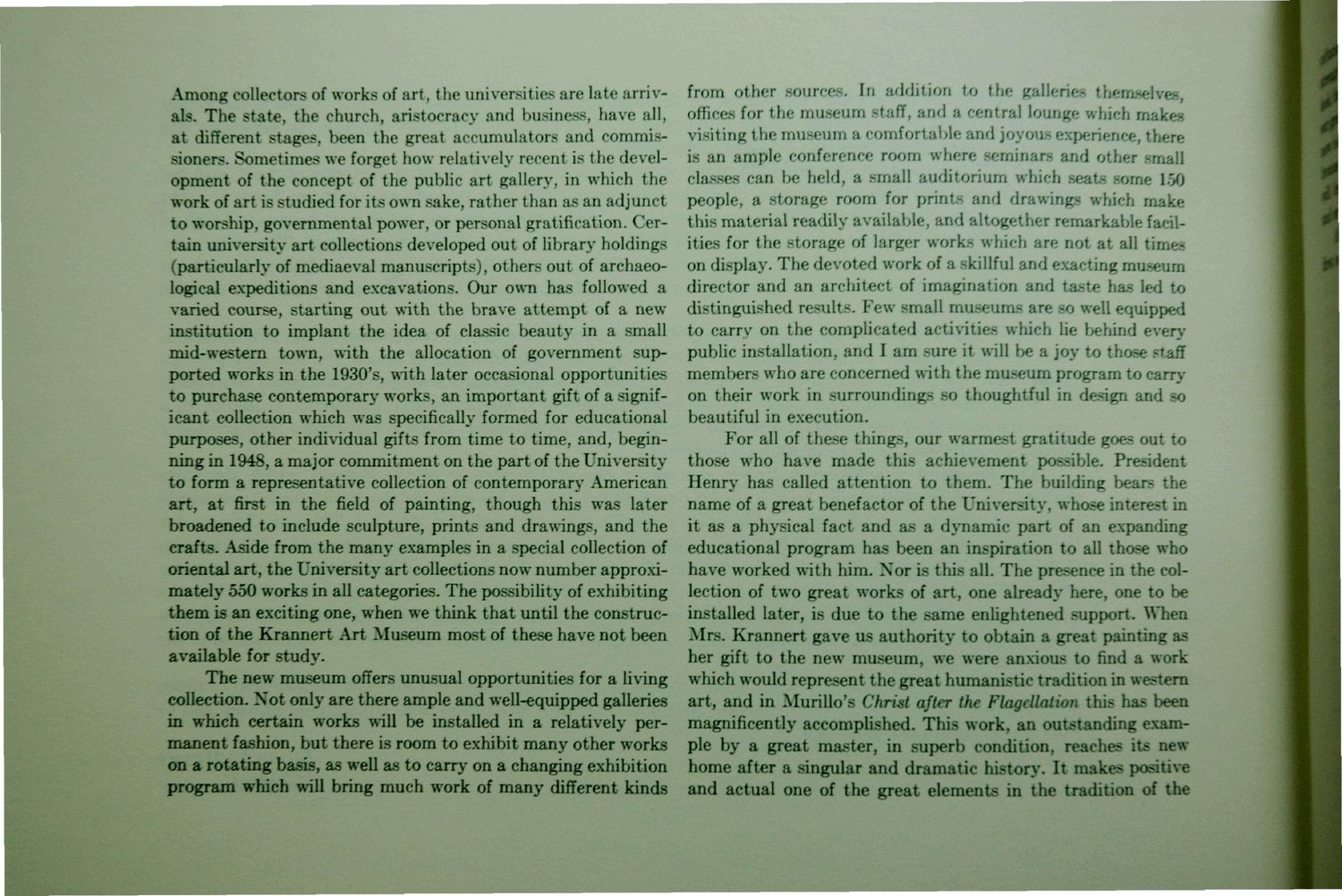| |
| |
Caption: Dedication - Krannert Art Museum
This is a reduced-resolution page image for fast online browsing.

EXTRACTED TEXT FROM PAGE:
Among collectors of works of art, the universities are late arrivals. The state, the church, aristocracy and business, have all, at different stages, been the great accumulators and commissioners. Sometimes we forget how relatively recent is the development of the concept of the public art gallery, in which the work of art is studied for its own sake, rather than as an adjunct to worship, governmental power, or personal gratification. Certain university art collections developed out of library holdings (particularly of mediaeval manuscripts), others out of archaeological expeditions and excavations. Our own has followed a varied course, starting out with the brave attempt of a new institution to implant the idea of classic beauty in a small mid-western town, with the allocation of government supported works in the 1930's, with later occasional opportunities to purchase contemporary works, an important gift of a significant collection which was specifically formed for educational purposes, other individual gifts from time to time, and, beginning in 1948, a major commitment on the part of the University to form a representative collection of contemporary American art, at first in the field of painting, though this was later broadened to include sculpture, prints and drawings, and the crafts. Aside from the many examples in a special collection of oriental art, the University art collections now number approximately 550 works in all categories. The possibility of exhibiting them is an exciting one, when we think that until the construction of the Krarmert Art Museum most of these have not been available for study. The new museum offers unusual opportunities for a living collection. Not only are there ample and well-equipped galleries in which certain works will be installed in a relatively permanent fashion, but there is room to exhibit many other works on a rotating basis, as well as to carry on a changing exhibition program which will bring much work of many different kinds from other sources* In addition to the galleries themselves offices for the museum staff, and a central lounge which makes visiting the museum a comfortable and joyous experience, there is an ample conference room where seminars and other small classes can be held, a small auditorium which seats some 150 people, a storage room for prints and drawings which make this material readily available, and altogether remarkable facilities for the storage of larger works which are not at all times on display. The devoted work of a skillful and exacting museum director and an architect of imagination and taste has led to distinguished results. Few small museums are so well equipped to carry on the complicated activities which lie behind every public installation, and I am sure it will be a joy to those staff members who are concerned with the museum program to carry on their work in surroundings so thoughtful in design and so beautiful in execution. For all of these things, our warmest gratitude goes out to those who have made this achievement possible. President Henry has called attention to them. The building bears the name of a great benefactor of the University, whose interest in it as a physical fact and as a dynamic part of an expanding educational program has been an inspiration to all those who have worked with him. Nor is this all. The presence in the collection of two great works of art, one already here, one to be installed later, is due to the same enlightened support. When Mrs. Krannert gave us authority to obtain a great painting as her gift to the new museum, we were anxious to find a work which would represent the great humanistic tradition in western art, and in Murillo's Christ after the Flagellation this has been magnificently accomplished. This work, an outstanding example by a great master, in superb condition, reaches its new home after a singular and dramatic history. I t makes positive and actual one of the great elements in the tradition of the
| |